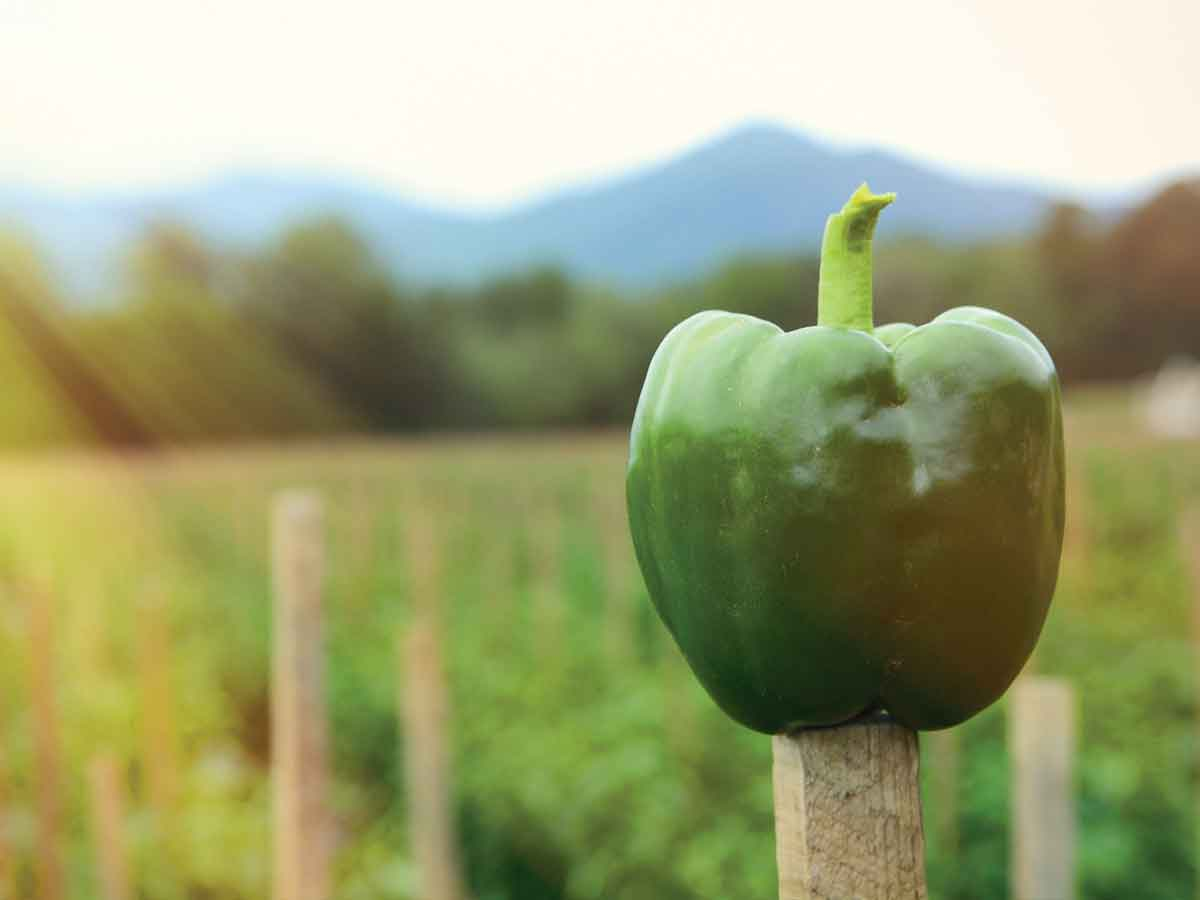‘It can’t be like that all the time’: Farmers recover from Fred amid inflation, weather worries
 A year after Tropical Storm Fred washed away his crop, Gary Griffith’s fields are once more full of green peppers. Holly Kays photo
A year after Tropical Storm Fred washed away his crop, Gary Griffith’s fields are once more full of green peppers. Holly Kays photo
When Gary Griffith woke up a rainy Tuesday on Aug. 17, 2021, he never imagined that by the next morning, the 12 acres of green peppers he’d grown along the Pigeon River in Bethel would rest in drifts miles downstream, the unofficial symbol of the catastrophic tragedy that was Tropical Storm Fred.
After the floodwaters receded, Griffith — like many other farmers in Bethel and Cruso — was left without a crop to harvest and tens of thousands of dollars in damage to repair. Before the flood, he’d picked only about 25% of his cucumbers and 45% of his peppers. Surveying the damage, he questioned whether it was even worth fixing. At 62, did it make sense to keep farming?
“Last year, I didn’t make anything, and I worked really hard to get back to zero,” Griffith said last week as he stood in his rehabilitated field, laden with ripe green peppers. Across the road hung rows of cucumbers, in total 20 acres of vegetables.
“You have to be able to withstand that sometimes, because you can’t predict the weather,” he said. “But it can’t be like that all the time.”
He wouldn’t have done it, he said, if not for his daughter and son-in-law, Cayleigh and Brandon Phillips. They’d been living out in Nebraska but wanted to come home to North Carolina, take over the farm, and raise their son, who’s not quite 2 years old. At 34, Brandon is much younger than the average U.S. farmer , who as of 2017 was 57.5 years old.
“I’ve been around farming my whole life, and farming of scale, too, so it is a massive undertaking but it ain’t, I guess, because I’m used to big numbers,” he said. In a “past life,” he managed a chicken farm of 1.5 million animals.
Related Items
“I’m glad they’re doing it,” Griffith said of the Phillips’ decision — but he’s also nervous for them. They left good-paying jobs to come farm in Bethel, and a farmer’s finances are anything but secure.
“You have to have price, quantity and quality,” he said “If you can get all three of those things, you’re going to be fine. But if you end up getting one of them, you’re not going to make any money. You can’t control the weather; you can’t control the price. You can do the best job you can do at your farm, and those other two things can make you or break you.”

- Brandon Phillips is preparing to take over the farm from his father-in-law Gary Griffith following the devastation of Tropical Storm Fred last year. Holly Kays photo
‘Gullywashers’ of aid
In addition to a lot of hard work, aid from local nonprofits and the N.C. Department of Agriculture and Consumer Services allowed Griffith to break even last year, though lack of profit meant covering any personal expenses, like groceries or mortgage payments, from savings. Some of those funds took so long to come through, he had to decide how much to plant this spring before knowing how much he’d recuperated from last year’s losses.
Local donations rolled in after the flood “fairly quick,” said Griffith, smaller amounts that nonetheless were instrumental in getting him through a difficult time.
“Then we had the politicians come in with the promise of everything,” he said, adding that those promises were much slower to be fulfilled, if at all.
“It has to be just about a perfect storm for you to get anything,” he said of the federal aid programs. “There’s so many conditions that you just don’t meet the criteria.”
Since he started growing vegetables nine years ago, Griffith has carried flood insurance through the U.S. Department of Agriculture’s Farm Service Agency, but the amount of money he got in return for the complete loss he suffered in 2021 was so small that he decided not to buy insurance at all this year.
“I’ve had it all these years, and it couldn’t get no worse than last year,” he said of the FSA insurance. “And I could have done without it. I did do without it.”
It came late, too. He applied for coverage immediately after the flood, and the check arrived about a month ago. He received a much larger relief check from the state around the same time, despite that application not becoming available until this spring, when the General Assembly allocated $50 million for assistance to farmers impacted by Fred.
“Ag funding always comes in little gullywashers,” said Haywood County Extension Director Sally Dixon. “It will be sunny, there’s not a penny in sight for anything farm-related, and then it rains suddenly. There’s all this money, and then it dries right back up.”
A whole new set of worries
Mere hours passed between the water’s sharp rise and equally sharp retreat last August, but the impacts to farmers could linger for years, Dixon said.
“It’s always a foolhardy measure to think that floods are a one-and-done kind of thing,” she said. “A lot of the aftereffects, particularly agriculturally, that happen from a flood, it takes years to figure that out and truly be back to 100%.”
The extension center has fielded “lots of calls” from people who are struggling with contaminated soil, eroded topsoil and out-of-whack nutrient and pH balances, said Dixon. All year, Griffith has been battling tenacious weeds in his pepper field, likely the result of seeds spread by the flood. Jay Johnson, vice president of operations at Haywood County distributor J.W. Tomato Co. , said one of the growers he works with had to bring in “many, many dump truck loads” of dirt to replace topsoil scoured away by the floodwaters.
Neither Johnson nor Dixon said they know of any farmers who quit the business following Fred’s ravages — but both said that 2022 could prove just as challenging as last year. Farmers are grappling with astronomic price increases to fertilizer , diesel fuel, labor and nearly every other input.
“A lot of them have chosen to cut back and scale their operations back a little bit,” said Johnson. “They’re always gambling when they plant a crop, but this is like the variables are stacked against them.”
While the harvest season is only halfway over, Johnson said his company is about 15% below normal in the volume of tomatoes it’s purchased so far this year.
“I think over the next two to three months we’ll really see what the effect of that has been,” Dixon said of the price increases. “Once we get closer to the end of the growing season, we’re going to see more people realizing that they’ve taken a loss, or that they’ve barely broken even because everything’s gotten so expensive this year.”
“Flooding is something that you worry about when it’s happening, but crazy high fertilizer prices they worry about all the way through,” Johnson added.
Griffith said his costs have “at least doubled” this year — but not his revenue.
“We’re still on five-year-ago prices,” he said.

- This May, farmers in Canton dealt with another wave of flooding, albeit less devastating than that caused by Fred. Jay Johnson photo
Focused forward
Griffith will never forget the thick muck and the sharp, earthy scent of green peppers that covered his fields the morning of Wednesday, Aug. 18, 2021. But he also can’t wallow in the memory.
Time moves on, and so does the weather.
“I already had hailstorm at the beginning of the season. We had to replant this whole field,” he said.
A week later, on May 27, another flood came through. It wasn’t nearly as devastating as the one resulting from Fred, and it didn’t affect Griffith. But closer to Canton, other farmers suffered.
Weathering the storm has always been part of farming, but the storms are coming fast and furious. Griffith worries for his daughter and son-in-law, but he also worries for all the young people who long to become farmers but can’t make the numbers work.
“When you love something that much, you work through the bad times because you know the good times are going to come,” said Dixon. “We’re all hoping that prices go down for next year. Hoping.”
“If you’re not comfortable with gambling,” said Griffith, “farming’s not the right thing to do.”









